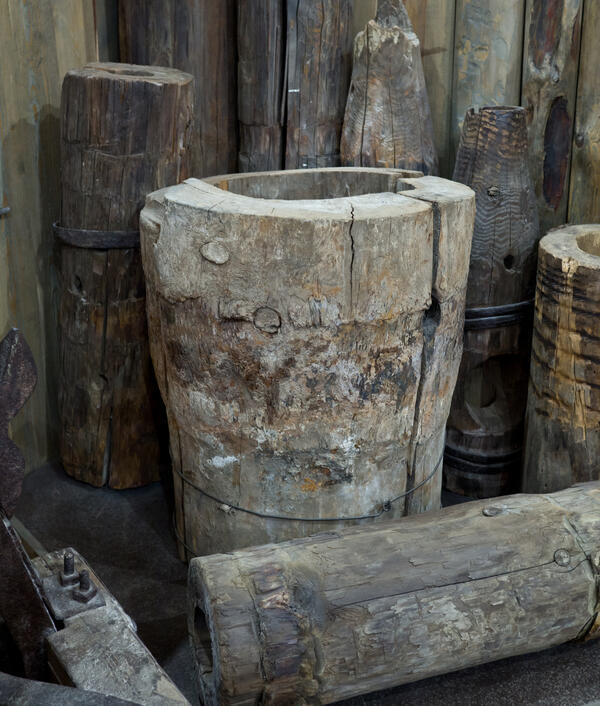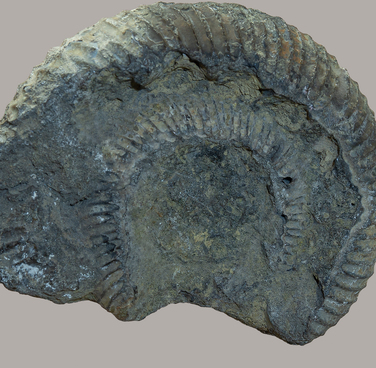The first major salt miners appeared on the Perm land in 1430. The NOvgorod merchants, the KalInnikov brothers, built salt boileries on the UsOlka River near its confluence with the KAma River. Alongside with the conquest and development of new lands, salt mining started its fast development in the KAma region. The concentrated salt brines, that is, underground salt sources, and large forests on hand contributed to the process.
The brine pipes were made of larch. The pipes were of various sizes in diameter to make it possible to insert one pipe into another to form a long brine-lifting chute.
It took from two to five years to bore a well and install pipes. As for small-scale salt mines, the brine was taken from the pipes with wooden buckets. The large-scale salt mines began to use hand pumps to pump the brine out at the end of the 16th century. Later, the pumps driven by horses were invented, while, by the middle of the 19th century, large salt producers already had pumps powered by a steam engine.
The brine from the pipe was firstly conveyed into large wooden chests made of thick boards and beams. Then the salt water was poured onto the salt boiling pans where boiled for 24-30 hours, depending on the concentration of the brine. Salt boiling pans are large pans designed to evaporate liquid out of salt.
After each boiling run, the salt boiling pans were cleaned, the ‘black stone’ was removed - the deposits of some salts stuck to the walls, and the ‘cod’ - the formations accumulated at the bottom of gypsum and clay limestone were hammered off. The brine was again poured onto the cleaned salt boiling pans and a new boiling run was started.
Despite the relative simplicity of salt production, it required division of labor and some special skills. The salt making masters and their assistants were involved in salt boiling. The brine was delivered to the pans by the water pourers. The fillers threw out the prepared salt from the salt boiling pan and packed it into sacks or bags, which were then carried away by the salt carriers. A special role was played by the salt boiling pan experts, foremen and blacksmiths.
The salt producers invited the best masters of pipe-making to design brine-lifting pipes and to seek for new brine spots. The foremen supervised all the work cycle of drilling wells and installing boilery pipes; the salt boilery success largely depended on their experience.
The brine pipes were made of larch. The pipes were of various sizes in diameter to make it possible to insert one pipe into another to form a long brine-lifting chute.
It took from two to five years to bore a well and install pipes. As for small-scale salt mines, the brine was taken from the pipes with wooden buckets. The large-scale salt mines began to use hand pumps to pump the brine out at the end of the 16th century. Later, the pumps driven by horses were invented, while, by the middle of the 19th century, large salt producers already had pumps powered by a steam engine.
The brine from the pipe was firstly conveyed into large wooden chests made of thick boards and beams. Then the salt water was poured onto the salt boiling pans where boiled for 24-30 hours, depending on the concentration of the brine. Salt boiling pans are large pans designed to evaporate liquid out of salt.
After each boiling run, the salt boiling pans were cleaned, the ‘black stone’ was removed - the deposits of some salts stuck to the walls, and the ‘cod’ - the formations accumulated at the bottom of gypsum and clay limestone were hammered off. The brine was again poured onto the cleaned salt boiling pans and a new boiling run was started.
Despite the relative simplicity of salt production, it required division of labor and some special skills. The salt making masters and their assistants were involved in salt boiling. The brine was delivered to the pans by the water pourers. The fillers threw out the prepared salt from the salt boiling pan and packed it into sacks or bags, which were then carried away by the salt carriers. A special role was played by the salt boiling pan experts, foremen and blacksmiths.
The salt producers invited the best masters of pipe-making to design brine-lifting pipes and to seek for new brine spots. The foremen supervised all the work cycle of drilling wells and installing boilery pipes; the salt boilery success largely depended on their experience.


